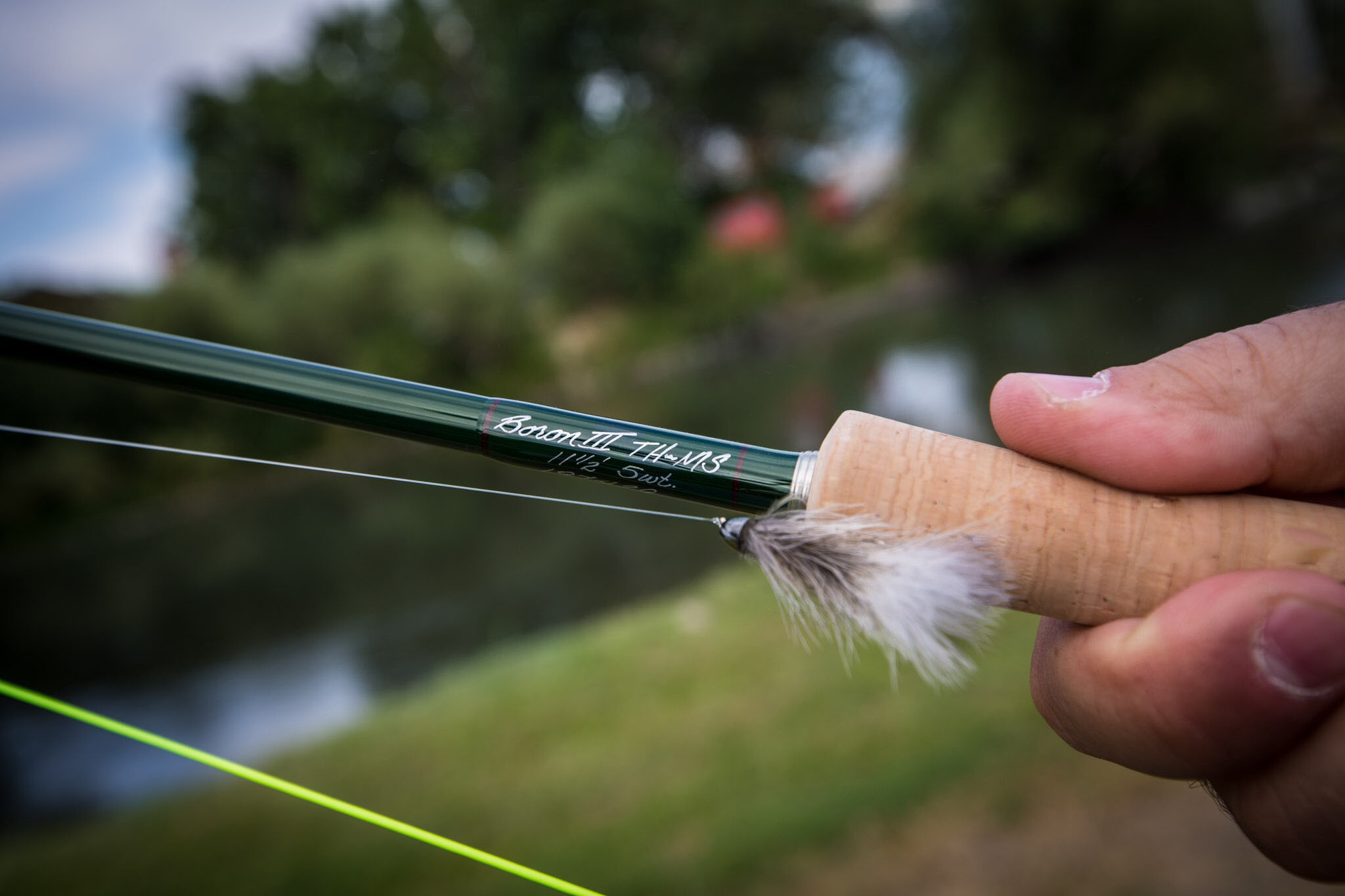Q: Tell us why you are so excited about these new Winston Boron III TH-MS Microspey rods?
TL: When I first moved to Oregon to guide the Deschutes, Spey fishing was just getting its legs under it. Back then, I had to convince most of my clients to try two-handed casting. These days, it’s almost uncommon to see an angler fishing a single-hand rod on the larger Northwest steelhead rivers. The Spey revolution has hit the Great Lakes steelhead scene in recent years as well. As more and more anglers have realized how fun and effective Spey casting is, it has started to creep into other fisheries, especially the trout world.
Over the past couple of seasons it has become obvious to me that the only thing holding back anglers from pursuing non-anadromous fish with two-handed rods was the equipment. While there are other small “switch” rods on the market, in my mind no company has produced a rod that would be fun to chase smaller species with.
That being said, the idea of building a “switch” rod is wonderful from a marketing standpoint. However, the reality is, when you try to make a product do “everything”, it usually does nothing exceptionally well. Inevitably the vast majority of “switch” rods on the market lean more towards an overhead taper. Consequently, they Spey cast about as well as a 2×4 piece of lumber. An advanced caster can make them work but unfortunately many anglers try to learn Spey casting with these incredibly stiff rods and usually get so frustrated they give the sport up.
We came up with the idea of “Microspey” because these rods lean heavy towards a true Spey taper. They have a powerful tip yet a smooth and groovy mid and butt section. The rods Spey cast beautifully! The smooth, medium-fast action is fun and easy to cast. Microspeys will overhead cast but anglers should expect the rods to excel at Spey casting.
Q: Do these rods have the same casting ‘personality’ as the larger Boron III TH two-handed rods? How are they different?
TL: Although the Microspeys fall into the Boron III TH family, the rods have a different personality than their larger cousins. In general, the Boron III TH sticks are faster. While the bigger sticks are unbelievably powerful, we wanted the Microspeys to possess more finesse.
Working on the Microspey rods with the design team at Winston was amazing. They have a wonderfully thorough process to ensure each rod model meets their high standards of precision performance. The role for creativity is still as paramount to them as the feel of the rod and making the rod a delight to cast.
Q: What is the expected ideal application for such long, light line TH Microspey rods? Trout fishing only?
TL: The Microspeys can be used in just about any fishing situation where a back cast is limited and more line control is desired.
The 11’6” #5 weight (300-390 grains) is the big gun of the family. It is ideal for throwing large streamers and heavy sink-tips. This is the Alaska sculpin/Rocky Mountain big ugly weapon.
The 11’ #4 weight (240-330 grains) is a great “all- arounder”. It has enough in the tank to throw small to medium-sized streamers yet is soft enough to swing soft hackles or caddis pupa. I fell in love with this rod while throwing mouse patterns in Alaska!
The 10’6” #3 weight (190-270 grains) is a real jewel to cast and is suited for lighter line applications. For anglers looking to swing soft hackles, dead drift nymphs or even fish dry flies, the #3 weight is the tool of choice.
When selecting a Microspey, anglers should keep in mind that two-handed line ratings differ from single-hand. An easy way to think about it is to consider a Spey line weight two line sizes heavier than a single-hand line weight. Consequently, the #3 weight Microspey is equivalent to a #5 weight single-hander.
While the Microspeys will, no doubt, find their way into trout angler’s hands, the rods are applicable to smallmouth bass, landlocked Atlantic salmon and smaller “half-pounder” steelhead. I am sure creative anglers will use them for other species!
Q: What makes a really great Spey and Microspey rod? What are their distinguishing characteristics?
TL: First and foremost, the rod needs to look beautiful. I love Winston fly rods because they have always set the bar for finish work, cork and components with their fly rods. Secondly, the rod needs to feel good in the angler’s hand. We spent a lot of time developing the size and shape of the handles on the entire Boron III TH series, including the Microspeys. While esthetics are important, the rubber meets the road with the action of the rod. The action is what makes or breaks the connection between the angler and their casting tool. In essence, it’s the rod’s soul. Part of what determines the action is the material of the blank. We’re continually amazed by how boron can increase a rod’s strength while still maintaining a smooth, buttery feel. Finally, the rod needs to fish well. For example, we used over-sized guides on the Microspeys to accommodate the larger diameters of Spey lines.
While working with the Winston design team, I saw their ability to imagine the performance and personality of a rod and develop on that. That’s how they create a rod with soul.
Q: What weight lines work best with these rods? Can you use standard weight-forward lines or do you need Spey lines? Which lines and grain weights do you recommend and how important is it to get the line matched to the rod?
TL: Spey lines can be very intimidating to new two-handed casters. To keep things simple, anglers should realize that just like in single-hand casting, there are specialty lines build for specific fishing situations. Some of these lines need to be aggressive and heavy for throwing sink-tips and big flies, while others are lighter and less aggressive for more subtle work near the surface.
Lines Weights for Spey Casting:
In the world of Spey lines, having the correct line weight for your stroke is critical for effortless casting. Our recommendations are based on what the “average” angler will feel comfortable with. Some anglers may vary line weights depending on personal preference. If you’re new to the sport, we recommend using the heaviest line suggestion.
11’6” #5 Microspey 11’ #4 Microspey 10’6” #3 Microspey
Skagit Head 390-360 grains 330-300 grains 270-250 grains
Scandi Head 360-330 grains 300-270 grains 240-210 grains
Line Weight for Overhead Casting:
While the Microspeys do have more of a true “Spey taper”, they will overhead cast short distances with a weight forward line. Anglers will want to go two line sizes heavier than the rod weight. For example, the 11’ #4 weight would take a #6 WF line.
Line Weight for Strike Indicator Nymph Fishing:
If an angler is using a line specifically for indicator nymph fishing, over-lining three line sizes works really well. For example, the 10’6” #3 weight would take a #6 WF line.
Q: What kind of anglers do you think will enjoy fishing these micro-spey rods?
TL: Obviously anyone already addicted to Spey casting and swinging flies will love these sticks. These rods simply extend two-handed fishing to a year-round season. We’ve talked a lot about experienced trout anglers looking for something to rejuvenate their passion for fishing. They’ve mastered other techniques and want something new and challenging. On the other hand, two-handed fishing is perfect for beginner. Swinging soft hackles on a small two-hander is about the easiest way to get a new angler hooked on fly fishing.



